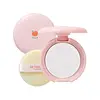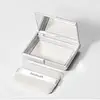What's inside
What's inside
 Key Ingredients
Key Ingredients

 Benefits
Benefits

 Concerns
Concerns

 Ingredients Side-by-side
Ingredients Side-by-side

Dimethicone/Vinyl Dimethicone Crosspolymer
Skin ConditioningMagnesium/Potassium/Silicon/Fluoride/Hydroxide/Oxide
Zinc Stearate
Cosmetic ColorantPolymethylsilsesquioxane
Mica
Cosmetic ColorantDimethicone
EmollientMagnesium Myristate
Silica
AbrasivePhenyl Trimethicone
Skin ConditioningHydrogen Dimethicone
1,2-Hexanediol
Skin ConditioningCaprylyl Glycol
EmollientSodium Dehydroacetate
PreservativePrunus Persica Fruit Extract
AbrasiveCalamine
AbsorbentTocopheryl Acetate
AntioxidantParfum
MaskingButylene Glycol
HumectantArgania Spinosa Kernel Oil
EmollientSesamum Indicum Seed Oil
EmollientEnantia Chlorantha Bark Extract
Skin ConditioningBeta-Sitosterol
Emulsion StabilisingSerenoa Serrulata Fruit Extract
Skin ConditioningTocopherol
AntioxidantOleanolic Acid
Skin ConditioningBenzyl Salicylate
PerfumingLinalool
PerfumingHexyl Cinnamal
PerfumingLimonene
PerfumingDimethicone/Vinyl Dimethicone Crosspolymer, Magnesium/Potassium/Silicon/Fluoride/Hydroxide/Oxide, Zinc Stearate, Polymethylsilsesquioxane, Mica, Dimethicone, Magnesium Myristate, Silica, Phenyl Trimethicone, Hydrogen Dimethicone, 1,2-Hexanediol, Caprylyl Glycol, Sodium Dehydroacetate, Prunus Persica Fruit Extract, Calamine, Tocopheryl Acetate, Parfum, Butylene Glycol, Argania Spinosa Kernel Oil, Sesamum Indicum Seed Oil, Enantia Chlorantha Bark Extract, Beta-Sitosterol, Serenoa Serrulata Fruit Extract, Tocopherol, Oleanolic Acid, Benzyl Salicylate, Linalool, Hexyl Cinnamal, Limonene
Mica
Cosmetic ColorantSynthetic Fluorphlogopite
Silica
AbrasiveDimethicone
EmollientMacadamia Ternifolia Seed Oil
EmollientHdi/PPG/Polycaprolactone Crosspolymer
Magnesium Myristate
Glycerin
HumectantIsopropyl Palmitate
EmollientMoringa Oleifera Seed Oil
EmollientButyrospermum Parkii Butter
Skin ConditioningEnantia Chlorantha Bark Extract
Skin ConditioningPearl Extract
AntioxidantCandida Bombicola/Glucose/Methyl Rapeseedate Ferment
AntimicrobialDiamond Powder
AbrasiveTriethoxycaprylylsilane
Pentylene Glycol
Skin ConditioningPolysorbate 20
EmulsifyingOctyldodecyl Stearoyl Stearate
EmollientAcrylamide/Sodium Acryloyldimethyltaurate Copolymer
Emulsion StabilisingHydrogen Dimethicone
Magnesium Aluminum Silicate
AbsorbentSorbitan Olivate
EmulsifyingSorbitan Stearate
EmulsifyingIsohexadecane
EmollientEthylhexylglycerin
Skin ConditioningPolysorbate 80
EmulsifyingSorbitan Oleate
EmulsifyingPolymethylsilsesquioxane
Butylene Glycol
HumectantPropylene Glycol
HumectantOctyldodecanol
EmollientTocopherol
AntioxidantCeramide NP
Skin ConditioningPhytosphingosine
Skin ConditioningHydrogenated Lecithin
EmulsifyingGlycine Soja Sterols
EmollientOleanolic Acid
Skin ConditioningOleyl Alcohol
EmollientSodium Dehydroacetate
PreservativePhenoxyethanol
PreservativePotassium Sorbate
PreservativeParfum
MaskingMica, Synthetic Fluorphlogopite, Silica, Dimethicone, Macadamia Ternifolia Seed Oil, Hdi/PPG/Polycaprolactone Crosspolymer, Magnesium Myristate, Glycerin, Isopropyl Palmitate, Moringa Oleifera Seed Oil, Butyrospermum Parkii Butter, Enantia Chlorantha Bark Extract, Pearl Extract, Candida Bombicola/Glucose/Methyl Rapeseedate Ferment, Diamond Powder, Triethoxycaprylylsilane, Pentylene Glycol, Polysorbate 20, Octyldodecyl Stearoyl Stearate, Acrylamide/Sodium Acryloyldimethyltaurate Copolymer, Hydrogen Dimethicone, Magnesium Aluminum Silicate, Sorbitan Olivate, Sorbitan Stearate, Isohexadecane, Ethylhexylglycerin, Polysorbate 80, Sorbitan Oleate, Polymethylsilsesquioxane, Butylene Glycol, Propylene Glycol, Octyldodecanol, Tocopherol, Ceramide NP, Phytosphingosine, Hydrogenated Lecithin, Glycine Soja Sterols, Oleanolic Acid, Oleyl Alcohol, Sodium Dehydroacetate, Phenoxyethanol, Potassium Sorbate, Parfum
 Reviews
Reviews

Ingredients Explained
These ingredients are found in both products.
Ingredients higher up in an ingredient list are typically present in a larger amount.
Butylene Glycol (or BG) is used within cosmetic products for a few different reasons:
Overall, Butylene Glycol is a safe and well-rounded ingredient that works well with other ingredients.
Though this ingredient works well with most skin types, some people with sensitive skin may experience a reaction such as allergic rashes, closed comedones, or itchiness.
Learn more about Butylene GlycolDimethicone is a type of synthetic silicone created from natural materials such as quartz.
What it does:
Dimethicone comes in different viscosities:
Depending on the viscosity, dimethicone has different properties.
Ingredients lists don't always show which type is used, so we recommend reaching out to the brand if you have questions about the viscosity.
This ingredient is unlikely to cause irritation because it does not get absorbed into skin. However, people with silicone allergies should be careful about using this ingredient.
Note: Dimethicone may contribute to pilling. This is because it is not oil or water soluble, so pilling may occur when layered with products. When mixed with heavy oils in a formula, the outcome is also quite greasy.
Learn more about DimethiconeWe don't have a description for Enantia Chlorantha Bark Extract yet.
Hydrogen Dimethicone is a type of silicone.
We don't have a description for Magnesium Myristate yet.
Mica is a naturally occurring mineral used to add shimmer and color in cosmetics. It can also help improve the texture of a product or give it an opaque, white/silver color.
Serecite is the name for very fine but ragged grains of mica.
This ingredient is often coated with metal oxides like titanium dioxide. Trace amounts of heavy metals may be found in mica, but these metals are not harmful in our personal products.
Mica has been used since prehistoric times throughout the world. Ancient Egyptian, Indian, Greek, Roman, Aztec, and Chinese civilizations have used mica.
Learn more about MicaOleanolic acid is a type of triterpene.
Triterpenes are chemical compounds found in various plants such as pomegranates, apples, basil, and rosemary. They have been shown to have anti-inflammatory and antioxidant properties.
Parfum is a catch-all term for an ingredient or more that is used to give a scent to products.
Also called "fragrance", this ingredient can be a blend of hundreds of chemicals or plant oils. This means every product with "fragrance" or "parfum" in the ingredients list is a different mixture.
For instance, Habanolide is a proprietary trade name for a specific aroma chemical. When used as a fragrance ingredient in cosmetics, most aroma chemicals fall under the broad labeling category of “FRAGRANCE” or “PARFUM” according to EU and US regulations.
The term 'parfum' or 'fragrance' is not regulated in many countries. In many cases, it is up to the brand to define this term.
For instance, many brands choose to label themselves as "fragrance-free" because they are not using synthetic fragrances. However, their products may still contain ingredients such as essential oils that are considered a fragrance by INCI standards.
One example is Calendula flower extract. Calendula is an essential oil that still imparts a scent or 'fragrance'.
Depending on the blend, the ingredients in the mixture can cause allergies and sensitivities on the skin. Some ingredients that are known EU allergens include linalool and citronellol.
Parfum can also be used to mask or cover an unpleasant scent.
The bottom line is: not all fragrances/parfum/ingredients are created equally. If you are worried about fragrances, we recommend taking a closer look at an ingredient. And of course, we always recommend speaking with a professional.
Learn more about ParfumPolymethylsilsesquioxane is a silicone used as a film forming agent.
When applied to the skin, this ingredient creates an invisible film on the surface. This film still allows oxygen to pass through, but prevents moisture from escaping. This can help condition and hydrate the skin. It also leaves a silky feel when applied.
Polymethylsilsesquioxane has not been shown to clog pores. It has been deemed safe to use up to 55%, but most cosmetics use much less.
If you have concerns about using this ingredient, we recommend speaking with a professional.
Learn more about PolymethylsilsesquioxaneSilica, also known as silicon dioxide, is a naturally occurring mineral. It is used as a fine, spherical, and porous powder in cosmetics.
Though it has exfoliant properties, the function of silica varies depending on the product.
The unique structure of silica enhances the spreadability and adds smoothness, making it a great texture enhancer.
It is also used as an active carrier, emulsifier, and mattifier due to its ability to absorb excess oil.
In some products, tiny microneedles called spicules are made from silica or hydrolyzed sponge. When you rub them in, they lightly polish away dead skin layers and enhance the penetration of active ingredients.
Learn more about SilicaThis ingredient is a preservative with antimicrobial properties. It is the sodium salt of dehydroacetic acid.
It is especially effective at preventing bacterial and fungal growth in low concentrations.
Tocopherol (also known as Vitamin E) is a common antioxidant used to help protect the skin from free-radicals and strengthen the skin barrier. It's also fat soluble - this means our skin is great at absorbing it.
Vitamin E also helps keep your natural skin lipids healthy. Your lipid skin barrier naturally consists of lipids, ceramides, and fatty acids. Vitamin E offers extra protection for your skin’s lipid barrier, keeping your skin healthy and nourished.
Another benefit is a bit of UV protection. Vitamin E helps reduce the damage caused by UVB rays. (It should not replace your sunscreen). Combining it with Vitamin C can decrease sunburned cells and hyperpigmentation after UV exposure.
You might have noticed Vitamin E + C often paired together. This is because it is great at stabilizing Vitamin C. Using the two together helps increase the effectiveness of both ingredients.
There are often claims that Vitamin E can reduce/prevent scarring, but these claims haven't been confirmed by scientific research.
Learn more about Tocopherol